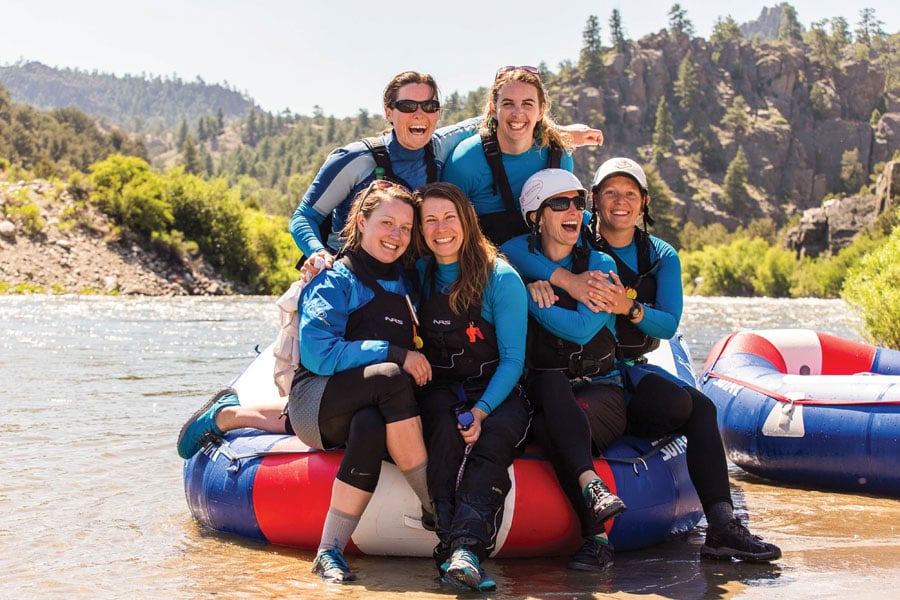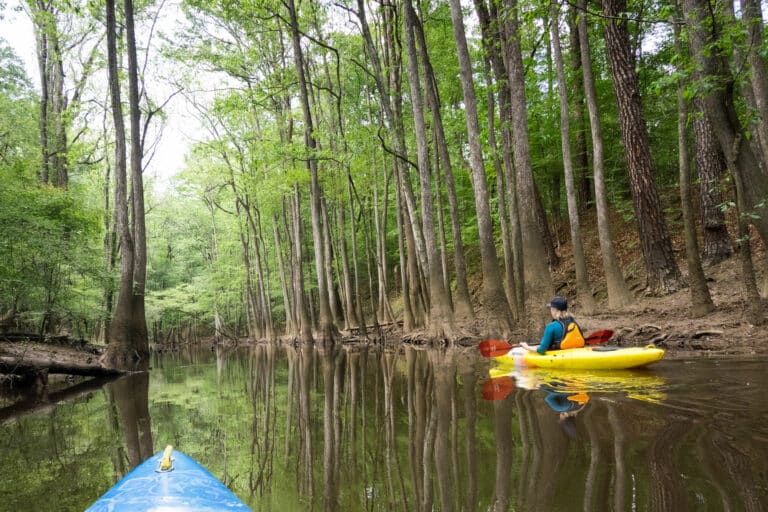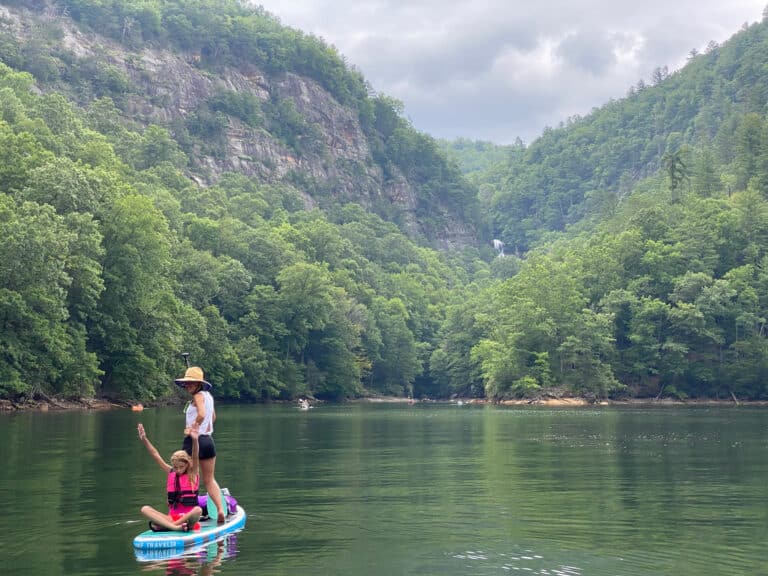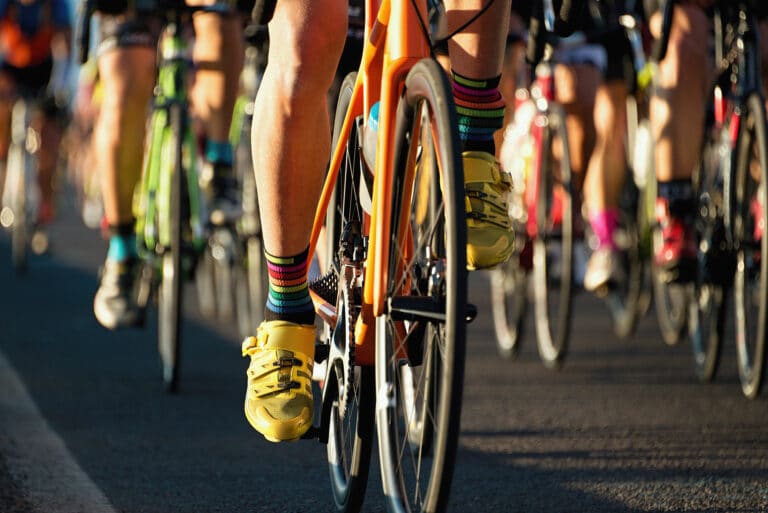It might be 2017, but the sexist attitudes of decades past are still prevalent in our society and they’re playing out on rivers and trails in ways you never have imagined.
Last year, an investigative report furnished by the U.S. Department of the Interior showed that women in the rafting industry have been the victims of sexual misconduct for years. The report zeroed in on the Grand Canyon River District in response to a letter of complaint filed by 13 former and current National Park Service employees who had experienced or witnessed “discrimination, retaliation, and a sexually hostile work environment.”
The subsequent investigation unveiled much more than that. Sexual propositioning, inappropriate physical contact, and verbal harassment were rampant, the report found, and the resulting disciplinary action was either inconsistent or insufficient.
Since the release of that investigation, thousands of women from all facets of the outdoor industry have stepped forward to share their stories. In 2016, over 2,500 women responded to a harassment poll conducted by Runner’s World. The results showed 43 percent of women answering, “always/often/sometimes,” to the prompt, “How often, if ever, does a stranger whistle at you, comment on your body, needlessly honk at you, or give you other similar unsolicited sexual attention?”
Similarly, Outside Magazine found earlier this year that 53 percent of women have been sexually harassed while recreating, and of that percentage, 93 percent have been catcalled, 56 percent have been followed by someone, 18 percent have been flashed, and 4 percent have been attacked.
All of that negative energy is bound to have consequences. Women who choose to take their adventuresport further, either competitively or professionally, must battle the misperception that women are weaker. That same Outside study found that 69 percent of women have been condescended to as an athlete. Another 82 percent felt that people expected less of them athletically due to their gender.
This is not okay.
What Happens On The River Stays On The River
Unique to the situation of raft guides is what happens after work hours. Raft guiding is a seasonal job lasting anywhere from three to six months. Most guides live in temporary housing, in the form of tents or cabins, alongside other employees and on company property. The distinction between work and play is blurry at best.
“It’s challenging just in that you’re living and socializing with your work partners,” says 33-year veteran guide and former ACE Chief of Staff Dave Bassage. “In most of the business world you’re not socializing with the people you work with in quite the same way. [As a raft guide] you may be working with your ex-boyfriend or ex-girlfriend, whereas in the real world you would be unlikely to face that challenge.”
For 22-year guide and Active Southern West Virginia Executive Director Melanie Seiler, the close-knit feel of raft guiding was something she treasured early on. The daughter of Susie Hofstetter, former owner of Songer Whitewater (which has since merged with Adventures on the Gorge), Seiler practically grew up on the New and Gauley Rivers.
“Raft guides felt like an extension of family,” she says. “They felt like uncles and brothers and sisters who were always looking out for me since I was a little kid.”
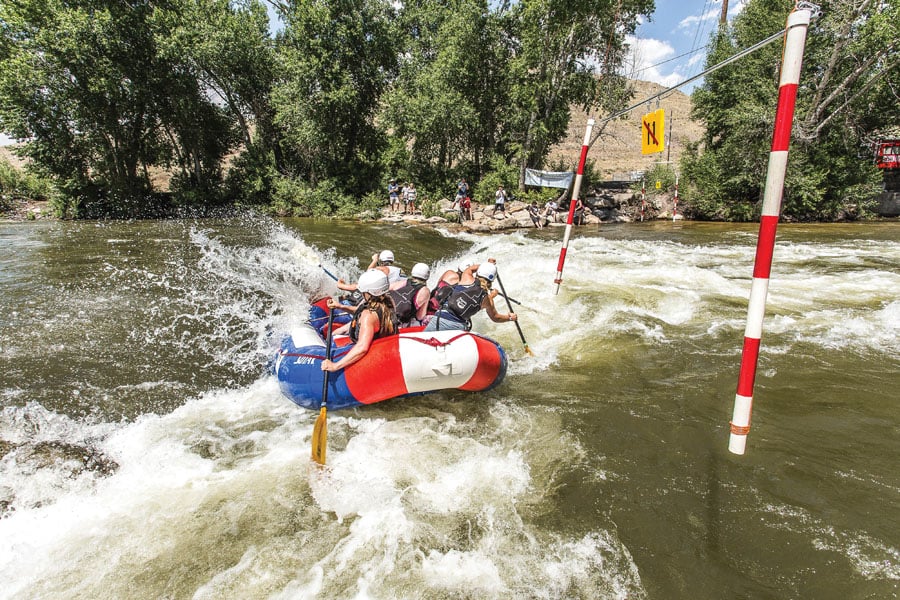
But soon, even Seiler’s love of the guide culture was put to the test when a male guide smacked her on the butt while she was pulling herself back into his raft. She was just 16 at the time.
“I can still feel that emotion,” she says. “I felt like I was in a vulnerable position. I was fully exposed. To get smacked in the rear end made me see red. As soon as I could stand myself up in the boat I smacked him across the face as hard as I could.”
[nextpage]
Before Seiler had the chance to tell her mother what had happened, the guide beat her to it. Hofstetter stormed out of the office, berating her daughter for treating a Songer employee so rudely. There was no mention of the guide’s action that had cause Seiler to react in the first place. She kept quiet.
It could be argued that Seiler’s situation was different in that her mother was her boss, too. But that uncomfortable encounter with the guide, and the subsequent absence of disciplinary action, is a story that’s all too familiar to female raft guides.
In the Grand Canyon investigative report, a Human Resources officer with the River District attributed the widespread and mostly unreported cases of sexual harassment to the “laissez-faire’ attitude of what happens on the river stays on the river.” The U.S. Department of the Interior found that victims who do file complaints, or refuse sexual advances, face retribution. “Women on river trips [are] forced to ‘walk the line’ between ‘not being hated and not being desired,’” said one Grand Canyon employee.
The guide who smacked Seiler’s butt was eventually fired after he exposed himself to another female Songer employee. But it was only then that Seiler finally felt comfortable enough to tell her mother the truth.
The Way It Is
“Literally the first week I showed up in Fayetteville I was told that to survive in this industry, you have to be okay with sexual harassment.”
That’s 32-year-old Karen (she asked us to not use her real name), a longtime raft guide who has worked the rivers of West Virginia for the past decade. When Karen trained in 2007, she trained under two male guides. One was very encouraging and professional. The other operated a “massage tent” in the evenings. He was not a licensed massage therapist.
“When you’re a trainee, you’re just another conquest,” she says. “It’s so much more difficult for women who are just starting. We have to just brush [harassment] off, because you’re either getting trained by these people, they’re paying you, or they’re your guests.”
Another guide, let’s call her Mary, felt similarly uncomfortable during her 2013 training experience. One of three ladies in a training class of 24, Mary, then 21 years old, appreciated that the outfitter made an effort to have at least one female trainer overseeing the instruction. She might have appreciated it more, though, had she actually had the chance to ride in the woman’s boat.
“It’s easier to learn from a female raft guide, but I was hardly ever in her boat,” she says. “The other guide always made sure I was in his boat. He would always make comments on my body. It was weird. I’m just meeting this person. Then you learn everyone’s like that and they say, ‘just brush it off,’ or, ‘that’s just the way it is.’”
That first season for Mary was challenging. Even after she checked out (being approved to take commercial rafts downriver), she was rarely scheduled on the Lower New. When the next season came around and she was given the sweep kit (which includes items like a radio and first aid kit and signifies a position of leadership), she was ecstatic. Finally, she was being given the chance to prove herself.
Around the same time, a male Trip Leader (TL) started paying extra attention to her. Mary thought the coquetry was benign enough. She started sweeping every other trip on the Lower New. Her confidence soared. But then, the TL’s ulterior motive became apparent. Mary started to feel signaled out. She stopped engaging in the banter, and he took the hint, but not subtly.
“One day he came and took the sweep kit from me and said, ‘I’ll be carrying that this trip,’” Mary remembers. “He said, ‘I don’t think you’re going to need that anymore.’”
Better, Not Equal
What Mary experienced was the quintessential definition of retaliation, but between the lines, there’s another troubling problem: women are not viewed as natural leaders.
“If girls are starting to become TLs before their male counterparts, it’s because they’re girls,” says 30-year-old Liz (who also requested anonymity). Liz has been guiding for seven seasons and trip leading for three of those, but she says that male guides still question her leadership. “The guys think it’s not that [women] are becoming TLs or sweeps because they have skill. It’s because they’re girls and they have boobs. It’s a lose-lose situation. If you get promoted, you’re discredited.”
Samantha Belcher, 30, couldn’t agree more. Belcher is no longer a full-time guide, but for seven seasons, she worked at Adventures on the Gorge and River Expeditions. For three of those seasons, she was a TL, but even with the added title and responsibility, she says she often struggled to feel like an equal.
“I feel like in rafting, in order to gain respect, you have to be better than your male counterparts,” says Belcher. “You literally have to work harder. Even if you run the same lines and you run them cleanly, you’re not as good. You have to be better than them in order to prove you are equal.”
That mindset is deeply engrained in the rafting culture. In the late ‘80s and early ‘90s, Susie Hofstetter was the only woman who owned a rafting outfitter. The other company owners didn’t question if she was business savvy enough to survive. They outright ignored her. And that was just fine by Hofstetter.
“These guys really weren’t going to change,” she says. “They have changed over time, almost 40 years later, but at that time I was just a girl to them. They didn’t think much of my ability or anything like that, which actually worked to my advantage. They didn’t pay much attention to me in a competitive way, so I was able to kinda keep under their radar.”
Eventually, they couldn’t help but notice. In its prime, Songer was taking 17,000 people downriver each season. Her business seemed to be doing better than ever, all amid a slew of family tragedies including the death of her 21-year-old son and an emergency hysterectomy.
“Finally [the other owners] were seeing that I could work hard, that I could get results, but it was tough,” she says. “I was very resentful of having to work harder to earn that respect because I had the personal issues going on and then I still had to kick their butts. I couldn’t do just as good. I had to do better.”
[nextpage]
The Guest Dynamic
Not all female guides have felt that pressure. At least, not from their peers.
Jo-Beth Stamm has been a guide since 2006. She trained with North American River Runners (NARR). The vibe there was supportive and encouraging for women, she says, not demeaning. Even now that NARR has since merged with ACE Adventure Resort, guides who worked for NARR are still self-proclaimed NARRtians, a testament to the tribe cohesiveness she felt.
Partly due to NARR being a small company, Stamm was pushed into a leadership role early on. By the fall of her second season, she was already a TL on the Lower Gauley, a position most guides don’t assume until their second or third seasons at the earliest. Despite the backing she felt from her fellow guides, Stamm says by and large, it’s been her guests who have been the most patronizing.
“I feel like I experience more challenges from my guests because I’m a woman,” says Stamm. “If a male TL says to a group, ‘Here are your guides, pick your poison,’ inevitably, you’re the last guide picked and then your crew feels like they got ‘stuck with the girl.’”
One experience that continues to bother Stamm took place in the summer of 2016. Her TL for the day assigned guests to guides, versus that damning “pick your poison” approach. One of her guests was a woman in her late 40s. Stamm immediately sensed her hesitation.
“She walks up to my boat and says, ‘Are you sure you can get us down this river?’ I just start rattling off my experience, that I’ve been doing this over 10 years, trying to make her feel confident but assuring her that it’s okay if she’s nervous.”
Next to Stamm was a third year guide, waiting for the next trip. He was lounging casually in the back of his raft, completely unaware of the conversation that was playing out next to him. Stamm’s guest-in-question took one look at the male guide and abruptly asked, “Well you’re coming too, right?” Stamm was floored.
“I asked her why she wanted him to come and she said, ‘I just need to know there is someone here who can keep me safe.’ I mean she’s looking at a dude who is sleeping in the back of his boat showing zero interest and feeling like she would be safer with him than with me. I literally told her, ‘We need to start over.’”
Plenty of female guides have felt similar frustrations with their guests, but more often than not, those guests are male. Karen, the 10-year guide, is 5’2″, 115 lbs. Early on, her guests were hardly shy about expressing their doubts.
“They would actually voice complaints that women shouldn’t be working on the river. They were openly disappointed,” she says. “It doesn’t happen as much now, but there will still be skepticism. I’ve learned a lot of posturing and I think that helps a lot. I come out of the gate strong and I have this whole persona that I’ve carefully crafted to shut them down. You have to shut them down, but in a way that they still give you money [tips] at the end of the day.”
The Delicate Dance
That persona that Karen’s talking about is considered an essential survival tool among female raft guides, but it’s also one of the most difficult skills to master. Raft guiding in general is largely associated with the party scene. Guests are usually on vacation, after all.
But for female guides especially, walking that line between engaging in the bawdy banter and experiencing outright harassment can be hard to distinguish and harder still to draw a clear line in the sand. Compounding the problem further is the fact that everyone’s boundaries are different.
“It is a kinda vulgar environment,” says former ACE Adventure Resort Chief of Staff Dave Bassage. “There are lots of dirty jokes, lots of flirting, lots of things that would be viewed as sexual harassment in the common workplace but is viewed as acceptable in the rafting world. There are some women who will tell raunchy jokes and be as outrageously flirtatious as the guys and there are others who take offense. Where the line is crossed is when someone expresses discontent and somebody else refuses to change that behavior as a result. That’s where I draw my line.”
“Honestly when I came out here, I kinda liked the raunchiness of things,” says Liz, the 30-year-old, seven-year guide. “It was fun and light-hearted and people had a good time. It was different. But I have been in situations where I’ve actually felt threatened by people that I thought were my friends. Then it’s the question of, was it meant to be a joke or is it actually crossing a line? You have to shut it down with no shades of gray. It’s black or it’s white.”
But to draw that line, women especially run the risk of losing the respect of their fellow guides and crew or, worse, of having their concerns dismissed altogether. And if you think the disparities solely exist between genders, think again: female guides can often be just as harsh, if not more so, as the men.
“In this community, there are women who are misogynists because masculinity is so celebrated,” says Samantha Belcher. “There are definitely older female raft guides that will tear down the younger female raft guides because that’s what they went through and they see it as socially acceptable. I’ve even seen them make comments that are similar to what guys would make about your body or your size or ability.”
Closing The Gap
The problems of sexual harassment and workplace inequality are far from being solved, but the industry has come a long way. When Dave Bassage was training as a guide in 1984, there was no employee handbook, let alone a policy on sexual harassment. Now, companies like ACE Adventure Resort take harassment seriously, showing educational videos to all 400 of their staff, many of whom are not river guides.
“The videos relate more to an office environment, so it’s not a perfect match for the outdoor industry,” says Bassage. “I think the topic of how to properly deal with harassment can and should be emphasized more and I think it should be addressed specifically to our industry, including some role playing and scenarios about what may or may not be acceptable.”
There’s no doubt there are more men than women currently guiding on West Virginia’s rivers, but the new wave of 2017 trainees showed a glimmer of change. Megan Becker, a 24-year-old first-year guide from Shepherdstown, W.Va., was the first to check out in her training class of 32. The next three who checked out were also women.
Becker doesn’t have a background in whitewater. In fact, she says, she had “a serious fear of water,” and decided learning to be a raft guide would be a good remedy for that. Even so, she says she has had nothing but positive experiences as a raft guide thus far.
“There were definitely days where my confidence was down and I didn’t trust my own instincts,” she says. “The other guides will joke with you about it if you mess up, but it’s all in good humor. They’ve never been cruel about it.”
A second-year male guide did make the comment that Becker was receiving good crews because, “you’re a pretty girl,” but beyond that, she says she hasn’t felt undermined or demeaned from her peers. In fact, the company’s river management came to her defense when some of her fellow trainees expressed discontent that she was getting more work than they were.
Collectively, the eight women we interviewed for this article have nearly 70 years of experience on the water, and all but a few continue to guide full-time through the season. Even in the face of uncomfortable scenarios, these women continue to push forward and take charge of the only thing they can control—themselves.
Their hope for the rafting industry’s future is that there will be strength in numbers. Companies like ACE Adventure Resort and Adventures on the Gorge already make efforts to recruit an equal amount of male and female trainees. Their websites feature photographs of female guides, but even still, argues Melanie Seiler, it’s not enough.
“There are a lot more women than there used to be,” says Seiler, “but how many females out there have not gone through with raft guide training because they didn’t want to deal with a male dominating industry? There needs to be a female river manager at every outfitter who can provide that perspective and help balance out the industry.”
All of the women agree that the industry is not entirely to blame for the current state of affairs. Society’s portrayal of gender norms in the media has a lot of influence still to this day, so when commercials feature bearded men as raft guides or movies showcase male characters saving female leads, it’s no wonder those same stereotypes are playing out on the river.
“While those things exist and they’re present and they’re not going away, there is such a larger part of the rafting community that is positive and that’s why I stay,” says Liz. “I have so many allies, not only female but also male, at my company and the community is supported. There is a want and acknowledgement from some people that things need to change and we need to treat women better.”
